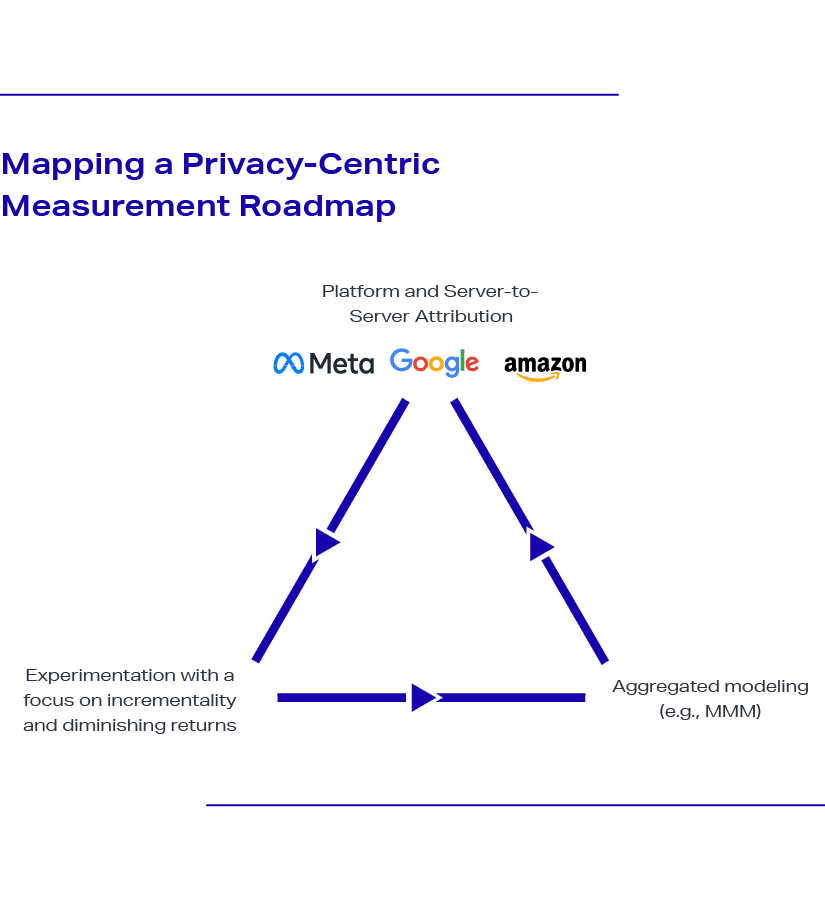Accessibility Tools
PMG Digital Made for Humans
The Future of MMM: Advancing Privacy-First Attribution & Durable Measurement
February 2, 2023 | 3 min read
The measurement landscape is as fragmented as ever as senior executives look to business transformation and digital-first marketing programs to make every media dollar work harder amid unprecedented market volatility.
As advancements in automation and machine learning supercharge the utility of standard measurement solutions, Media Mix Modeling (MMM) has become a must-have for any well-organized media program.
For brand marketers to swiftly navigate this moment and answer investment attribution questions from the C-suite confidently, returning to the fundamentals of media measurement while adopting privacy-first measurement solutions can deliver for the brand and larger business.
Marketing measurement solutions are the talk of the C-suite as marketers accelerate data, analytics, and measurement roadmaps to gain a better line of sight into business performance amid market volatility and the accelerated pace of change.
The measurement landscape is as fragmented as ever, and the journey toward holistic, robust marketing measurement can seem difficult. As a result, many marketers fall into the trap of focusing on the here and now, and settling for at-hand platform signals and attribution models rather than building durable measurement programs.
This short-term focus on adopting the latest platform attribution update can distract from the importance of building long-term durability within a brand’s measurement program.
Fortunately, automation and machine learning advancements have supercharged the utility of standard measurement solutions, transforming practices like Media Mix Modeling (MMM) into a must-have for any well-organized media program.
These advancements allow measurement models to better account for the interaction between marketing touchpoints and drive faster, more applicable insights on media performance.
“Advancements in automation and machine learning have supercharged the utility of standard measurement solutions, transforming practices like Media Mix Modeling (MMM) into a must-have.”
Behind the headlines of shifting timetables for third-party cookie deprecation, the announcements of new data cleanrooms to combat signal loss, and mounting privacy regulation, there’s a unique opportunity to reset and return to the fundamentals of media measurement.
For brand marketers who seek to swiftly navigate this moment and answer investment attribution questions from the C-suite with confidence, these post-privacy practices can deliver for the brand and the larger needs of the business.
Educate Leadership and Key Partners
In many organizations, the first step toward advancing a more durable measurement roadmap is educating stakeholders on how the privacy-first digital media ecosystem works, what’s changing, and outlining clear best practices and next steps for building durable data and measurement programs.
This allows marketers to champion the importance of a post-privacy measurement strategy among key leaders and decision-makers.
As advertising becomes more privacy-conscious, measurement strategies must be supported by stronger partnerships with finance, legal, and technology teams as regulatory compliance, true ROI measurement, and zero- and first-party data capture require cross-functional expertise and technologies.
Establish Privacy-Conscious Platform Benchmarks
A shifting privacy landscape gives rise to myriad testing opportunities, attribution updates, and platform solutions.
In light of these changes, marketers must closely monitor regulatory action and platform-based changes to truly understand how user tracking and attribution modeling are shifting quarter over quarter. Where possible, testing into privacy-focused and automation-based solutions that can operate in parallel with cookie-based measurement will help brands set new benchmarks and compare against prior attribution models.
For example, PMG recommends that brands consider implementing Conversions APIs with ad platforms, such as Google and Meta, and monitor conversion attribution coverage over time. Many brands are also opting to implement Google Analytics 4, which offers future-proofed capabilities in tracking and measurement.
We recommend dual tagging (with prior versions of Google Analytics or Adobe Analytics) while launching a new web analytics platform, allowing brands to compare attribution and develop new benchmarks.

Build a Durable Measurement Roadmap
For a majority of brands, the future of measurement will look more like triangulation across multiple approaches, including platform attribution and modeling, aggregated modeling, such as Media Mix Modeling, and experimentation.
These approaches require time and resources to establish—both of which will demand technical resources (e.g., data and vendor capabilities to build MMM) and cross-functional organizational buy-in (e.g., building a culture of experimentation).
Despite Google punting third-party cookie deprecation to 2024, brands need to invest in post-cookie measurement solutions now to be prepared for whatever the future may bring.
PARTNER FOR AGILITY
Marketers can accelerate their measurement roadmap by identifying where in the process they need to build and own solutions versus partnering for speed and agility.
For example, PMG recently partnered with Best Western Hotels & Resorts to refresh the brand’s approach to media mix modeling and create incrementality testing roadmaps by soliciting an RFP process to select a third-party MMM provider while continuing to partner with PMG to support model implementation from onboarding through activation.
This allows the brand to own first-party data collection while partnering with a third-party vendor for media data management. Whether the best solution is to partner externally or manage in-house, the ultimate goal is to maintain agility when building and activating privacy-first attribution and durable measurement solutions.
Final Thoughts
The Bottom Line
Measurement will only grow more complex as marketing programs expand to adopt new platforms, pursue new audiences, and engage with new technologies.
Educating stakeholders and establishing new platform benchmarks are the first steps for ensuring brands can build—and sustain—measurement programs equipped to flex and accommodate future needs.
With federal privacy legislation on the docket and cookie deprecation on the horizon, brands that begin their journey towards privacy-centric measurement today will be better prepared for whatever the future of advertising may bring.
Champion New Approaches, Educating Key Leadership
Establish Privacy-Conscious Platform Benchmarks
Test & Measure by Building a Durable Measurement Roadmap
Remain Flexible While Partnering for Agility
About the Author
Written by Laurie Miller